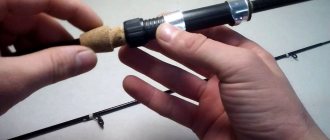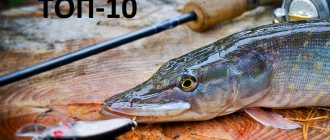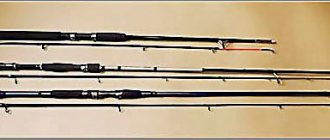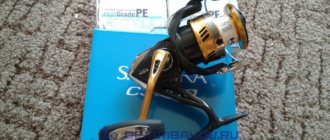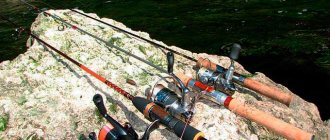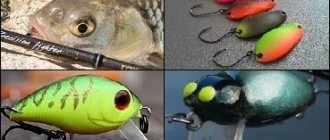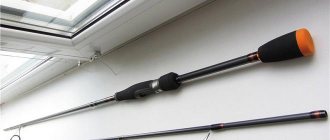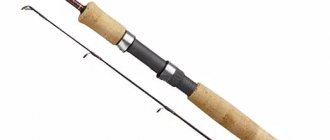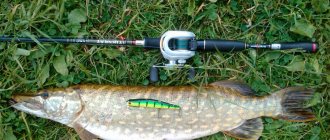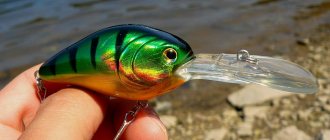Main classes
You can determine whether a fishing rod belongs to a specific action by the markings located near the reel mount or in any other place. There are three main classes:
- Fast – fast formation, indicated by the letter “F”.
- Regular/Medium – medium tuning. Manufacturers mark it with the letters “R” or “M”.
- Slow – slow or parabolic tuning marked “S”.
There are also border groups - super-fast and medium-fast.
To determine the class in the absence of a designation, it is enough to study the bending of the fishing rod under the influence of a static load. A professional angler will be able to complete this task in a couple of seconds, but a beginner will need to rest the tip of the blank against the ceiling and apply a little pressure. The resulting shape of curvature will indicate the tuning.
Blanks made from hard materials have a faster action than models made from soft wood or composite.
Criterias of choice
There is no doubt that when choosing fishing equipment, you should give preference to purchasing with a known quality, and this is guaranteed by a product from a well-known brand, purchased from a reliable retail outlet. The choice of telescopic spinning rod begins with an inspection of the knee joints, the number of which can vary from three to nine elements. Having spread the rod to its full length, check the blank for rigidity by shaking the spinning rod. In a reliable thing, there are no backlashes and inaudible extraneous sounds. The form should not be noodles. If the quality of the tool is normal, the angler will feel the tension of the tackle without any failures in movement.
Important! It is worth paying attention to the accuracy of fitting the rings, which should not move when unfolding, touch each other and bend when folding the gear.
It is preferable to choose a spinning rod with a cork handle and a reel seat made of a light metal alloy, which can at least somehow affect the reduction in weight of the equipment. Having completed the visual inspection and making sure that there are no visible defects, they determine the operating parameters of the spinning rod, selecting the version suitable for the expected fishing conditions. In this direction, the fisherman should highlight the criteria for determining the optimal length of the tackle, the material used to make the rod blank, its structure and test parameters. These values depend on the type of bait used, the type of reservoir being fished and the structure of the coastline, which affects casting, the intensity and methodology of the fishing method. It is on these selection parameters that we will dwell in more detail in the continuation of the article, pointing out to the angler the possible options for choosing.
Material of manufacture
Telescopic spinning rods, like many other fishing equipment, are made from composite plastic materials that differ in the variants of binding components represented by different types of polymers. The most widely used materials for making fishing rods are fiberglass, carbon fiber, also known as carbon, and composite. Fiberglass telescopes are considered reliable and non-fragile, resistant to dynamic loads and at the same time flexible. But the big disadvantage of fiberglass is its weight. Telescopic spinning rods made of fiberglass are heavy and quickly tire the angler’s hand. Although, their so-called oakiness helps in the fight against powerful fish and has a positive effect on casting distance.
Carbon fiber tackle is much lighter than fiberglass, more sensitive and has better balance, but is fragile. Such tackle requires careful care of the form. After all, sand that gets on the fishing rod and, as a result of folding the telescope, scratches the surface of the material, renders the fishing rod unusable. The price of carbon fiber telescopes is high. The best option is to purchase a composite spinning rod, which, in terms of material properties, is intermediate between the examples presented above. It is reliable, undemanding to operating conditions, and the cost is in the rank of budget gear.

Test values
The test values of the telescopic stick are chosen based on what baits the angler most often intends to use during fishing. It’s worth mentioning right away that you’re unlikely to find this type of gear in ultralight, but in the range of medium and heavy class versions of telescopic spinning rods, there’s more than enough. These are the ones you should focus on when planning to purchase tackle of this design.
Typically, telescopes are labeled with test values in grams, ounces or pounds. The range indicated on the form will indicate the optimal weight of the baits used for fishing, which should not be neglected, especially when going beyond the upper limits, to avoid overloading the gear, which is already sensitive to loads due to the large number of joints. In the middle class, the optimal range is 10–30 grams. It is more rational to buy a more powerful rod with 20-50 grams. Such values cover a significant mass of baits suitable for catching freshwater predators.
Length
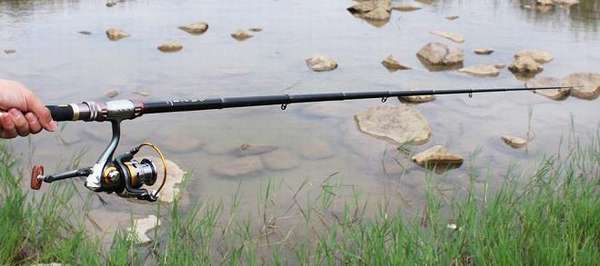
The length of a spinning telescope should be selected based on the conditions of the planned fishing. Such conditions include where the angler will cast the bait from. For example, shore fishing is significantly different from fishing done from a boat. In turn, coastal fishing may also have differences. Coastal fishing conditions vary depending on the structure and presence of thickets in the coastal zone from which casts are made. If the clean shore comes close to the water area of the reservoir without the presence of coastal and coastal thickets of reeds, bushes and trees with a crown hanging over the water, then for long-range spinning rods with the longest blank are selected. Under such conditions there are no obstacles to the swing. If there is a tree crown nearby or close to suitable bushes and reeds, throwing the bait with long tackle is inconvenient and risks the bait getting caught on obstacles.
Fishing from a boat is limited by the space of the vessel, and range fades into the background, due to the fact that you can swim close to a promising point. Therefore, for cramped conditions, hunting from a boat and inconveniences, telescopes with a length of 1.6 to 2 meters are selected. When hunting from ideal positions, look for gear with a blank length of 2.1–2.7 meters.
Important! Long telescopic spinning rods are flimsy and quickly fail as a result of irreparable play in the maple joints.
Build
The ability of the blank to bend without affecting its strength is called the structure of the tackle. There are three main characteristics of fishing rods for this parameter: fast, medium and slow. The spinning rod is selected according to the formation based on the animation control of the baits.
Important! The stiffer the blank, the better it is to control the play of the wobbler, silicone and spinner.
But at the same time, with rigid tackle it is more difficult to catch large fish, which can break the rod that does not absorb shocks. Telescopic spinning rods are easiest to find in medium action, since the design features, and in particular, the heterogeneity of the blank due to the large number of joints, do not allow ideal balancing of the tackle for fast, and even more so slow action. Telescopic versions of medium-action spinning rods are universal in use and allow you to comfortably and efficiently work with many types of baits without fear of equipment breakage. An average spinning rod in the test will cover most fishing conditions.
Medium action
Among anglers, the average action of a spinning rod is often called the “golden mean”. Therefore, if you are a beginner and are just starting to understand all the intricacies of spinning fishing, it is better to choose this option. This stiffness class is characterized by versatility and is suitable for most conditions.
Spinning rods with medium action (Medium/Moderate) bend 2/3 of their own length. They are effective when fishing on large rivers or lakes from the shore, where you need to make long casts of bait and control them. Elite models have excellent sensitivity, which is important when fishing using the jig method.
A blank with a medium degree of hardness is suitable for fishing using oscillating and rotating spoons, crankbaits and deep wobblers. It can be used in still water or with a slight current. Some fishermen use spinning rods with medium action in twitching, making elegant movements with minnow wobblers.
How to choose a spinning rod for a beginner
Spinning rods for beginners must meet the parameters that strive for universal characteristics. In this case, a beginner will be able to use the rod in a wider range of predator fishing without fear of disabling it or losing a significant part of its ability to control the bait. There is no universal spinning rod in nature, but you can still find options close to this.

You can select a spinning rod from average values, and such tackle will be suitable for a beginner, especially at the beginning of his career, for all cases of fishing strategies. With experience will come an understanding of the nuances of fishing, and therefore, there will be a desire to move towards specialization of gear, focusing on a certain type of fishing and the use of bait.
Selecting length and test
The length of the spinning rod for fishing from the shore, with closer parameters suitable for boat fishing, is about 2.7 meters. We will start from this stick when deciding which spinning rod to choose for beginners. To work with medium-sized wobblers and silicone baits, weighing from 6-20 grams, as well as all types of spinners, it is enough to purchase a rod in the test range of 10-40 grams. Don't be embarrassed by the high entry threshold. A ten-gram entry into the test will provide opportunities for six-gram baits to work, not ideally, but in practice this is quite acceptable. More critical is the use of masses beyond test limits.
Scale selection
The action of the tackle is transient, medium-fast. Such modifications are increasingly coming into practical use and allow you to optimally feel the bait and make high-quality retrieves, without losing the ability to make long-distance casting. A spinning rod for beginners should not be an expensive model, so it is wiser to choose a product made from fiberglass materials. Let the tackle be a little heavier than its carbon-fiber counterparts, but it will behave stronger and more reliably in case of mistakes in a beginner’s stick-handling technique. The sensitive spinning rod did not work out in this example, but still, this tackle will definitely instill the initial skills of a novice spinner. And this is the purpose of choice in such a situation.
What kind of fish is it suitable for?
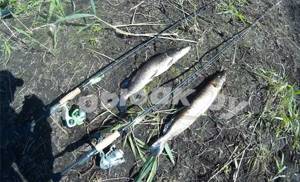
We have already looked at how to choose the right spinning rod, let’s try to consider what type of fish can be caught with our gear. The range here is also quite wide. In most cases, the opportunity to catch a variety of fish species is provided by the bait used. The gear allows you to fish with a jig, and therefore the catch will include pike, pike perch, perch and even catfish.
Build and test make it possible to comfortably deal with twitching topics. Twitching allows you to include chub, trout and rudd in the list of possible trophies. Long-distance casting and the use of spinners - the important factor here is which spinning rod system to choose - undeniably gives you a chance of catching an asp. Having discussed above how long a spinning rod should be and choosing the average option, we came to the conclusion that with this gear you can successfully fish from the shore, and with the least problems you can fish from a boat.
The best spinning rods are, without a doubt, specialized models, but for the average fisherman, a model that is distinguished by its versatility is quite suitable, which is what we tried to convey to the reader.
Slow build
Slow action rods bend more than 2/3 of their length. Their distinctive feature is their long casting range, which allows them to send bait over distances of more than 100 meters. The parabolic action also perfectly absorbs strong jerks of the fish, preventing possible prey from falling off the hook.
It is effective when fishing for large predators, such as pike perch and asp, using jigs.
Slow-action forms are also used for catching pike with oscillating spoons in spacious lakes and reservoirs.
With the ultralight fishing method, it is allowed to use rods for trout fishing with micro-oscillators and small silicone products.
Classification of spinning tests by class
| Ultralight (UL) | Light (L) | Medium Light (ML) | Medium (M) | Medium-Heavy(MH) | Heavy (H) | Extra-Heavy (XH) |
| 1-7 g 0.5-5 g 1-7 g 2-7 g | 5-10 g 2-10 g | 8-15 g 7-21 g | 7-35 g 5-25 g 7-28 g 10-30 g | 25-40 g 10-40 g | 40-100 g | More than 100 g |
The table shows the most common test ranges in 7 classes of spinning rods. The international standard is highlighted in bold. There is nothing wrong if your spinning rod is not marked according to the international standard. For example, a spinning rod with a test of 5-25 g is designed exclusively for such weights; 35 g will be superfluous for it. The action of the rod plays a big role; probably, such a spinning rod has a slow action and the whip bends quite strongly at any load above 25 g.
Ultralight is ideal for microjigging, small rotating and oscillating spinners of sizes 00, 0 and 1. Small wobblers with a weight of 7 g are also suitable. Fishing conditions for ultralight are ponds, lakes and small rivers with a depth of no more than 2 meters. The flow is either absent or small. Stronger currents require heavy baits and you will feel uncomfortable using light baits in such conditions.
Light is well suited for small rivers, ponds and lakes with deeper places where it is important to reach the bottom with bait.
Medium Light and Medium are already quite heavy classes that will allow you to throw baits of 14-30 g up to 80-100 m from the shore. These are jig weights of baits. This style allows you to fish from the shore even on large reservoirs and large rivers, but there is still a condition that the current should not be too strong, otherwise the bait will be carried away strongly, the wiring will not be so clean and attractive to the predator.
Medium-Heavy are heavy jig spinning rods that allow the angler to fish with heavy baits weighing up to 40 g. In conditions of strong currents and depths of more than 10 meters, such a spinning rod is a prerequisite for spinning fishing. It is most popular when fishing for pike perch or catfish in holes with strong currents.
Heavy and Extra-Heavy - both types of spinning rods are used when catching catfish, but even more often as a rod for trolling, where the bait is large wobblers or twisters with a heavy jig head, which in turn are in the water under the constant pressure of the water flow from -for planing the boat. These circumstances require increased rigidity from the rod.
Please note that reliable data on the spinning rod test is written on the butt of only branded spinning rods. Chinese products, especially telescopic ones, often have incorrect information. And most of these “spinning sticks” are not used for their intended purpose, but as “feeder gear”. In quotes because the sensitivity of such gear is very insignificant, and the feeder must be sensitive.
Choosing the optimal system
To choose the optimal spinning rod system, you need to decide on the type of prey it is intended to catch. This is explained by the fact that different fish differ in their habits and the strength of their jerks, so if one class of hardness remains effective, another can lead to damage to the tackle and the trophy coming off the hook.
It is better to catch pike with hard spinning rods made of carbon. The toothy predator has a muscular mouth, so the likelihood of independently catching a hook in the mouth is minimal. The angler will have to perform a strong hook to break through the pike's jaw.
It is better to avoid ultra-fast action models, because... a large specimen will easily damage such a form, and the process of fishing with a large bend will be problematic.
